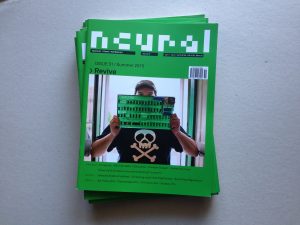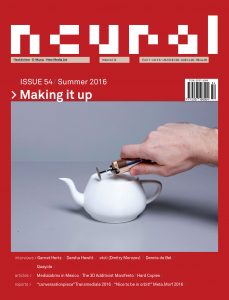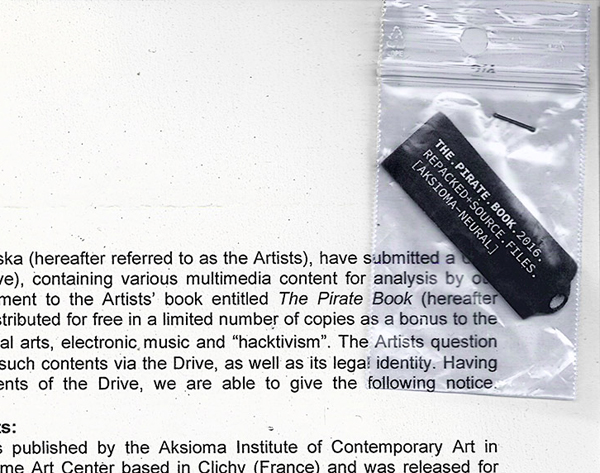Alessandro Ludovico is the editor in chief of Neural magazine – a monthly publication dedicated to ‘new media art’ and the ongoing developments occurring in the fields of contemporary art, music and design amongst others. His research is broadly centred around the archaeology of art and technology and the meaning of media and technology use.

Ars Electronica 2011: MO, 05.09.: Prix Forum V – Interactive Art. Im Bild Alessandro Ludovico (IT). Foto: rubra
Maja Lorkowska: First of all can I just ask out of curiosity – isn’t it a bit early for archaeology?
Alessandro Ludovico: It is never too early. Technological development has been so fast, there are plenty of prototype ideas; media which has been created, invented and died even before they were adopted. But it is extremely interesting to rediscover them now and try to track and trace what exactly they represented, and what they could represent now. So obviously history plays a great role, but it is more a history of science and technology.
ML: I see. Let’s talk about Neural – how do you pronounce it?
AL: “Neural”, “Nüral”,”Noiral”. We wanted to have an Italian title and an English one but we’ve discovered it actually works perfectly in German too! We founded it in November 1993.

Neural Magazine, Issue 51, from the Neural archive
ML: That’s the year of my birth!
AL: I can imagine that… I’m happy that you’re young but that reminds me that I’m getting older and older!
ML: Age equals experience, so I wouldn’t worry!
AL: Yes! The short story is that my friend used to run, and still does, an electronic music label and I was working for him as a graphic designer., I was 24 at the time. And I pestered him to make some kind of publication with CDs so that they could have been released officially by the music label. We did a couple: one was very popular, it was printed two years before, in 1991. It was called “Virtual Reality Handbook” and it sold out in less than a year. Then I convinced him to start working on Neural just a couple of years later.
ML: What prompted it and inspired you in the first place?
AL: Actually, it has evolved a lot, as you can imagine. In 1993 I got my first email address, just before the first issue was out. We couldn’t easily access the web at that time, it sounds like pre-history. It was a very peculiar period because there was a boom in the media surrounding virtual reality which was already popular and the internet was becoming a social phenomenon. Working for an electronic music label, we were quite… I wouldn’t say geeks, but we were quite fascinated by everything technological. For me that was especially true on the graphic design side, and for my friend on the music side, as he was and still is a musician. So we had a fascination for technology but we also shared a passion for treating them as media; how they contributed to the creative media scene as a whole. And also the impact they had almost 25 years ago – having technologies promising to create virtual worlds, and the internet which aimed to connect the whole world in real time.
The main thing for us was to embody a discourse about these different media in the format of a magazine and that was a challenge. And the reason why we wanted to do it is because we wanted to create a magazine that we would have really wanted to read – that’s probably the main motivation.
ML: That’s as good a motivation as any – if you can’t find something, you do it yourself.
AL: Yes, exactly. We simply really wanted to make something that we would have compellingly read. So at that time, it was a topical moment: we felt something like the holy fire of doing it! Then we put together the topics we were already aware of and I started to travel and met interesting early net artists all around Europe, who completely opened my mind. I don’t want to sound nostalgic about that – but that was a great moment and then it obviously evolved over time.

Neural Magazine, Issue 54, from the Neural archive
ML: But the main part of an independent and critical magazine like Neural is to reflect what is going on.
AL: Since the beginning we tried to make what we called a ‘magazine of ideas’. It’s not about finding a formula and sticking to it forever, but it’s really trying to reflect, in every possible respect, on the topic you’re formulating after constantly observing what is happening, tackling them in the magazine. For example, in the 2000s there was a lot of user-specific, sometimes custom-made software in artworks, and I would say that in the last six to seven years everything has become much more fluid. With every possible kind of technology available, there has been a revamp of analogue media. So I have always thought the magazine should be ‘the son of your time’. It should really embody what’s going on, and the aim is to pick up on what’s not so well known.
For us it’s always been a question of finding unexpected materials, unexpected connections and mostly also artists, curators and theorists whose quality speaks for themselves. To produce original content. Also let me say one thing too as it is something we are very proud of. In 23 years the amount of public funding we received is zero.
ML: Really?!
AL: Not even one Euro cent. We started with our own pocket money and we became sustainable through subscriptions and adverts. I’m proud of it because we were able to create a adaptable model so I’d always be keen to talk with independent publishers to motivate them – I’ve done it, you can do the same, you don’t need to stick with public money and stop when public money is gone. Which is often the case nowadays.
ML: It certainly is and in the broader art world most people aim for that.
AL: Yes, and I think, as the British say, you shouldn’t put all your eggs in one basket, look for different streams of revenue. Public money isn’t always the only way.
ML: You mentioned looking at things that would normally go unnoticed, exploring the work of lesser known artists. Have you noticed any recurring trends recently on this more niche scene, during the time you’ve been involved with the magazine?
AL: Well, I’ve always been very passionate about the topics we deal with, the magazine still has these old three keywords which are ‘new media art’, which can, of course, be totally questioned as a definition; hacktivism and e-music.
In terms of trends, now it’s even more interesting than before for one specific, which is that the newer generations are very keen to get rid of any possible category within any possible medium. For me this is a major trend. What I mean is that for them it is absolutely natural to go from one kind of medium to another. I think it’s somehow reflecting what is going on in different fields but at the same time it’s very promising in terms of the results. So we can find quite interesting results in the work of artists that are trying out other options and producing artworks that would have been inconceivable just a few years before. So within these borders there is a lot going on, but sometimes you have to look harder to discover it and start to talk with people to realise it. But then it’s even more satisfying for us.

Neural Magazine, from the Neural archive
ML: What is the significance of having a printed magazine especially because you’re dealing with digital media most of the time?
AL: There could be an endless answer because of my specific research – I have researched the topic of print and digital quite extensively. To start, we wanted to reflect the new technological aspect we were living in the 90s, and the relationships that people started to be forced to have also. So we made quite a few experiments with graphic design, for example: the first 6 issues we had the page numbering in binary code (but then the printer told us we had to stop otherwise he would stop printing it because it was driving his crazy!)
Jumping to the current situation, we have a printed magazine in English, we have a digital edition of the printed magazine which you can subscribe to and we have the free website too, which are its three major embodiments. It is important to have the printed magazine – and I’ve started to explore it from a really scientific point of view through academic research. The reading experience of printed material, for example, is very very different compared to reading it digitally. There are also plenty of other reasons: the print edition from an archival point of view will likely last way longer than our digital editions. Printing it out also means it will be read by a lot of people that potentially would not read the same material on a screen. So these are the major reasons, but of course there would be even more. And the aim is also to experiment with these different formats. We often involve artists to intervene in the magazine, new media artists mainly, sometimes also to provide an extra object or content that is usually shipped to all subscribers. I can give you some examples if you like?
ML: Yes, of course!
AL: Just to talk about one of my favourites, which is in issue #53: in the magazine there is a small plastic bag with a USB drive in it. On it there is a PDF file of a book, written by a French and Polish artist duo, Nicolas Maigret and Maria Roszkowska. The book is called “The Pirate Book” which is a really interesting investigation on pirate practices. More importantly, on the USB drive they actually included the original material of their investigation, for example the first torrent and some other material which is quite controversial. They used this material for their research which obviously isn’t integrally included in the book, but with a USB we can easily distribute it. They then asked a law firm in Paris to evaluate the potential crime committed distributing this kind of information with this USB drive and the lawyers sent back a dossier of six pages in which there is an evaluation of all the folders in the drive. The final outcome was that in the magazine we printed one of the pages of the dossier and we stapled the plastic bag with the USB on top of it, making it look like something out of a crime TV series!
Neural issue 53, extra USB, Nicolas Maigret Aksioma.
ML: There seems to be something of a recurring visual theme amongst internet artists – and perhaps this applies predominantly to the mainstream group – but there is a very ‘glitchy’ look to a lot of work. What do you think about this?
AL: If you look at the glitch movement, to be brief, it has a completely different meaning now. The problem is that when you have a specific aesthetic within mass media for a while, more than once, then it very quickly becomes just another part of the media-scape, becoming invisible somehow. So this type of aesthetic, glitch – used to make much more sense in the past. Now having the glitch theme just reminds us of trying to look at YouTube videos with a lousy WiFi connection. It does become a kind of universal dialect. I understand that, I am very critical of most of the contemporary art market. There are brilliant things in the contemporary art world but often there are just strong trends that transverse it for quite a while and quickly disappear. And this is exactly the opposite of what we have doing for almost a quarter of the century with Neural.
On the other hand, there is something else worth mentioning, which is that contemporary art has always had a big problem with digital media because they are not meant to produce unique work, and therefore it is not suited to produce the value attached to that original. But at the same time such a widespread aesthetic phenomenon could not be ignored forever. So even if, for example, Internet Art was quite ignored during the 90s, eventually the whole world is dealing with this development now, as we all have smart computers in our pockets with beautiful screens so we can’t just dismiss that. They carry artworks, they are part of our lives, so art, in one way or another, has to have a voice within that. And in my very humble opinion, the only way contemporary art wants to deal with that is aesthetically. Behind the aesthetics, there’s a lot more which is hard to ignore. There are social processes, technical changes, political consequences, there are also very personal, intimate consequences – all of that has to emerge. I’ve always thought that’s just a question of time, but that will at some point emerge quite powerfully also in contemporary art. The only parallel I can make has been with video art which has been quietly dismissed in the beginning – it took 20 years to be officially acknowledged by contemporary art. But now it’s been more than 20 years that we’ve had Internet Art around and still not very clearly, not mentioning properly, acknowledged in art history.
ML: I wonder whether that’s because it is physically difficult to represent, considering that key way to experience art has always been through the physical space of gallery. Perhaps it is just a logistical problem?
AL: You’re absolutely right, this is a crucial problem, but we should wonder then! What is included in the’ white cube’ – is it still representing what’s going on on the outside? Or is the white cube still self-sufficient enough to represent reality? The risk is that we are still sticking to a format that would miss quite relevant chunks of reality. But again, it is also attached to huge economic consequences especially in western countries.
ML: So do you think this is what the future holds right now?
AL: Oh totally! I mean I personally think that there are two elements in contemporaneity which truly changed the world in the last 20 years and still, they are completely underestimated in every possible cultural sector. The two elements are software and networks. Software – because it is leading most of our processes at the greatest possible level. Networks – because since the beginning of the 90s they have reshaped world connections on various levels. But we are still thinking in a classic, traditional way when it comes to society, to relationships among people and even to our own world as a unique territory. I think that these two elements are absolutely crucial, so the re-thinking of the white cube is essential as and I am seriously starting to think that it is something quite obviously outdated.

The poster with the magazine covers, from the Neural archive.

From the Neural archive.











